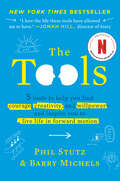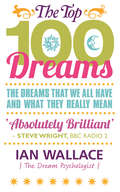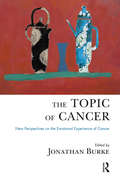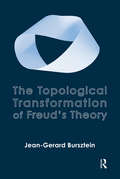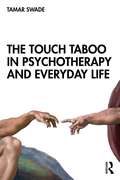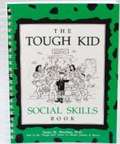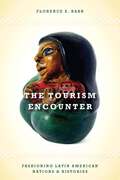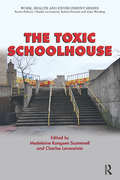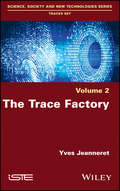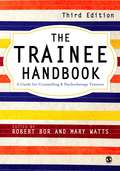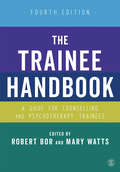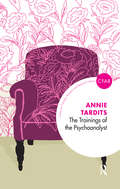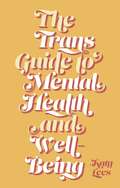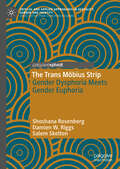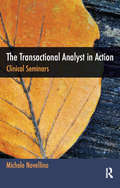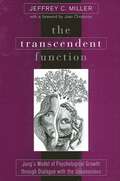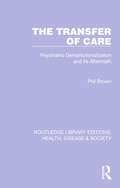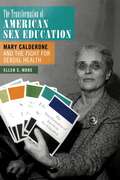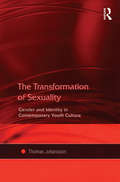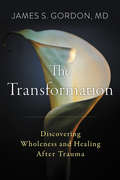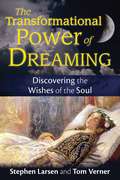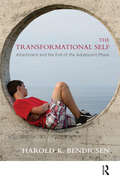- Table View
- List View
The Tools: 5 Tools to Help You Find Courage, Creativity, and Willpower--and Inspire You to Live Life in Forward Motion
by Phil Stutz Barry MichelsA groundbreaking book about personal growth that presents a uniquely effective set of five tools that bring about dynamic change--as seen on The Dr. Oz Show The Tools offers a solution to the biggest complaint patients have about therapy: the interminable wait for change to begin. The traditional therapeutic model sets its sights on the past, but Phil Stutz and Barry Michels employ an arsenal of techniques--"the tools"--that allow patients to use their problems as levers that access the power of the unconscious and propel them into action. Suddenly, through this transformative approach, obstacles become opportunities--to find courage, embrace discipline, develop self-expression, deepen creativity. For years, Stutz and Michels taught these techniques to an exclusive patient base, but with The Tools, their revolutionary, empowering practice becomes available to every reader interested in realizing the full range of their potential. The authors' goal is nothing less than for your life to become exceptional--exceptional in its resiliency, in its experience of real happiness, and in its understanding of the human spirit."An 'open secret' in Hollywood . . . [Stutz and Michels] have developed a program designed to access the creative power of the unconscious."--The New YorkerFrom the Hardcover edition.
The Tools: 5 Tools to Help You Find Courage, Creativity, and Willpower--and Inspire You to Live Life in Forward Motion
by Phil Stutz Barry MichelsNEW YORK TIMES BESTSELLER • &“I love the life these tools have allowed me to have.&”—JONAH HILL, director of StutzChange can begin right now. Learn to bring about dynamic personal growth using five uniquely effective tools—from psychotherapist Barry Michels and psychiatrist Phil Stutz, subject of the Netflix documentary Stutz, directed by Jonah Hill.&“These tools are emotional game changers. They do nothing less than deliver you to your best and most powerful self.&”—Kathy Freston, author of Quantum Wellness The Tools offers a solution to the biggest complaint patients have about therapy: the interminable wait for change to begin. The traditional therapeutic model sets its sights on the past, but psychiatrist Phil Stutz and psychotherapist Barry Michels employ an arsenal of techniques—&“the tools&”—that allow patients to use their problems as levers that access the power of the unconscious and propel them into action. Suddenly, through this transformative approach, obstacles become new chances—to find courage, embrace discipline, develop self-expression, deepen creativity. A dynamic, results-oriented practice, The Tools aims to deliver relief from persistent problems and restore control and hope right away. Every day presents challenges—big and small—that the tools transform into opportunities to bring about bold and dramatic change in your life. Stutz and Michels teach you how to: • Get Unstuck: Master the things you are avoiding and live in forward motion.• Control Anger: Free yourself from out-of-control rage and never-ending grudges.• Express Yourself: Learn the secret of true confidence and find your authentic voice.• Combat Anxiety: Stop obsessive worrying and negative thinking.• Find Discipline: Activate willpower and make the most of every minute. With The Tools, Stutz and Michels allow you to realize the full range of your potential. Their goal is nothing less than for your life to become exceptional—exceptional in its resiliency, in its experience of real happiness, and in its understanding of the human spirit.
The Top 100 Dreams: The Dreams That We All Have and What They Really Mean
by Ian WallaceLearn to speak the language of your dreams... We all dream, but our dreams often seem to be bizarre and confusing experiences that make little sense to us, no matter how much we try to analyse them. The key to understanding our dreams is looking beyond individual symbols and being able to see the bigger picture in the stories that we choose to create every night. There are 100 of these dream themes that are consistently reported by dreamers everywhere in the world, regardless of country or culture. These top 100 dreams appear again and again because they reflect fundamental life patterns. By recognising them, you will begin to achieve a much deeper understanding of your dreams and yourself. The Top 100 Dreams explains why you dream them, and suggests how you can use them to help you realise your most cherished hopes and aspirations in everyday life.
The Topic of Cancer: New Perspectives On The Emotional Experience Of Cancer
by Jonathan BurkeThis book focuses on our emotional responses to cancer by offering a range of perspectives: psychoanalytic, medical, spiritual and religious, as well as literary. Once suppressed, akin to a taboo, the topic of cancer is now very much in the public consciousness. The prevalence of the disease and well-publicised medical advances in its treatment demand it. Topic of Cancer begins with Freud's cancer, widely known of but rarely understood in its historic and analytic context. Psychotherapeutic reflections are then offered on our understanding of the adult and adolescent with cancer, and the challenges of sustaining a thoughtful presence in the face of the trauma experienced when a child is diagnosed with cancer, and during treatment. The dilemmas and challenges faced by today's psychotherapist with cancer are explored next and, for the first time in cancer literature, an account of the emotional demands on nurses involved in sensitive, intimate care. With an increasing number of people living longer with cancer, “survivorship†and palliative care are the focus of the chapters that follow.
The Topological Transformation of Freud's Theory
by Jean-Gerard BurszteinIn this book the author presents his reading of psychoanalysis in the spirit of its founder Sigmund Freud, and explores the transformations of Freud's work by his followers. The author notes that some of these followers trimmed it down even to exclude the death drive, which was one of Freud's fundamental principles. Freud's theory has also been transformed by Lacan, who, in the mid-1950s embarked on a lifelong enterprise to recast it in a fruitful debate with the sciences and the humanities. Such a transformation brought by Lacan was (somewhat paradoxically) necessary to show the importance of Freud's findings for the understanding of subjectivity.
The Touch Taboo in Psychotherapy and Everyday Life
by Tamar SwadeTouch has been a taboo in mainstream Western talking therapies since their inception. This book examines the effects on us of touch, and of touch deprivation – what we feel when we are touched, what it means to us, and the fact that some individuals and cultures are more tactile than others. The author traces the development and perpetuation of the touch taboo, puts forward counterarguments to it, outlines criteria for the safe and effective use of touch in therapy, and suggests ways of dismantling the touch taboo should we wish to do so. Through moving interviews with clients who have experienced life-changing benefits of physical contact at the hands of their therapists, the place of touch in therapy practice is re-evaluated and the therapy profession urged to re-examine its attitudes towards this important therapeutic tool. This book will be essential reading for therapists, counsellors, social workers, educators, health professionals and for any general reader interested in the crucial issue of touch in everyday life.
The Tough Kid Social Skills Book (Tough Kid Series)
by Susan Sheridan Tom OlingFocuses on teaching social skills to the student who displays excesses in noncompliance and aggression and deficits in self-management.
The Tourism Encounter: Fashioning Latin American Nations and Histories
by Florence E. BabbIn recent decades, several Latin American nations have experienced political transitions that have caused a decline in tourism. In spite of--or even because of--that history, these areas are again becoming popular destinations. This work reveals that in post-conflict nations, tourism often takes up where social transformation leaves off and sometimes benefits from formerly off-limits status. Comparing cases in Cuba, Mexico, Nicaragua, and Peru, Babb shows how tourism is a major force in remaking transitional nations. While tourism touts scenic beauty and colonial charm, it also capitalizes on the desire for a brush with recent revolutionary history. In the process, selective histories are promoted and nations remade. This work presents the diverse stories of those linked to the trade and reveals how interpretations of the past and desires for the future coincide and collide in the global marketplace of tourism.
The Toxic Schoolhouse (Work, Health and Environment Series)
by Madeleine Kangsen Scammell Charles LevensteinThe Toxic Schoolhouse is a collection of articles on chemical hazards endangering students, teachers, and staff in the education system of the United States and Canada. Some of the articles were originally published in a special issue of New Solutions: A Journal of Occupational and Environmental Policy, but all have been updated and several new articles have been added. The book is organized in three sections. The first describes problems ranging from the failures of coordination, monitoring, and siting of school buildings to the hazards of exposure to toxic substances, including lead and PCBs. The second section captures the voices of activists seeking change and describes community and union organizing efforts to improve school conditions. The third section covers policy "solutions." The authors include academics, union staff and rank-and-file activists, parent organization leaders, and public health professionals.
The Trace Factory
by Yves JeanneretThe collection and treatment of traces which reveal who we are and what we do naturally piques our interest when it pertains to others, and anxiety when it concerns ourselves. Do we truly know what a trace is? And if knowledge is power, how vulnerable are we in the public sphere? The demonstrability of a trace hides the complexity of the process that allows it to be produced, interpreted and used. This book proposes a reasoned approach to the analysis of the 'trace' as an object and as a sign. By following such an approach, the reader will understand how the media participates in the creation and deployment of traces, and the issues raised by what can be traced on social media. The Trace Factory offers a historical perspective, returning to the founding theories of collecting and producing traces linked to knowledge and power in society. Observing technology and information through the prism of these theories, a large number of devices and their uses are evaluated. This book offers itself as a tool of thought and work for researchers, professionals and social actors of all kinds who are confronted with the existence, treatment and interpretation of the traces of society and culture.
The Trail to Tincup: Love Stories at Life's End
by Joyce Lynette HockerIn The Trail to Tincup: Love Stories at Life&’s End, a psychologist reckons with the loss of four family members within a span of two years. Hocker works backward into the lives of these people and forward into the values, perspective, and qualities they bestowed before and after leaving. Following the trail to their common gravesite in Tincup, Colorado, she remembers and recounts decisive stories and delves into artifacts, journals, and her own dreams. In the process the grip of grief begins to lessen, death braids its way into life, and life informs the losses with abiding connections. Gradually, she begins to find herself capable of imagining life without her sister and best friend. Toward the end of the book Hocker&’s own near-death experience illuminates how familiarity with her individual mortality helps her live with joy, confidence, and openness.
The Trainee Handbook
by Robert Bor Mary WattsThe Trainee Handbook, Second Edition, is designed as a companion to training in counselling, counselling psychology and psychotherapy. Unlike most texts which focus on theory and practice, this bestselling book identifies the broader knowledge and skills you will need to succeed in your training and as you make your first steps in practice. Written by a team of leading trainers, practitioners and supervisors, The Trainee Handbook provides advice on practicalities such as writing essays and case studies and examines issues which affect all practitioners in the early stages of professional development and particularly in preparing for the first meeting with a client. This Second Edition has been fully revised and updated, and features new chapters on: o case formulation; o personal and professional development; o continuing professional development. Dealing with the practicalities and common concerns of students, The Trainee Handbook, Second Edition provides an invaluable source of information and guidance for anyone undertaking training in one of the therapy professions. Professor Robert Bor is Consultant Clinical Psychologist at the Royal Free Hospital, London. Professor Mary Watts is Pro-Vice-Chancellor for Teaching and Learning at City University, London and Professor of Psychology.
The Trainee Handbook: A Guide for Counselling & Psychotherapy Trainees
by Professor Mary Watts Professor Robert BorWritten by a team of leading trainers, practitioners and supervisors, this bestselling classic is the trainee therapist's best friend. It identifies and guides trainees through the practical skills and knowledge they'll need to make a success of their training - from writing essays, through case formulation, and on to preparing for their first meeting with a client. Along the way, it addresses and allays the concerns which are common to all students. Now in its fourth edition, the book has been fully updated to take account of the significant changes in the therapy professions in recent years. It now includes new and important chapters on: · Evidence-based practice · Working with diversity · Reflective practice · Using social media, technology and online therapy The Trainee Handbook is an invaluable companion, and source of information and guidance for all trainees in counselling, psychotherapy and counselling psychology, and newly-qualified therapists entering into practice.
The Trainee Handbook: A Guide for Counselling & Psychotherapy Trainees
by Professor Mary Watts Professor Robert BorWritten by a team of leading trainers, practitioners and supervisors, this bestselling classic is the trainee therapist’s best friend. It identifies and guides trainees through the practical skills and knowledge they'll need to make a success of their training - from writing essays through to case formulation and on to preparing for their first meeting with a client. Along the way, it addresses and allays the concerns which are common to all students. Now in its fourth edition, the book has been fully updated to take account of the significant changes in the therapy professions in recent years. It now includes new and important chapters on: Evidence-based practice Working with diversity Reflective practice Using social media, technology and online therapy The Trainee Handbook is an invaluable companion, and source of information and guidance for all trainees in counselling, psychotherapy and counselling psychology, and newly-qualified therapists entering into practice.
The Trainings of the Psychoanalyst (The Centre for Freudian Analysis and Research Library (CFAR))
by Annie TarditsIf psychoanalysis, for freud, was an impossible profession, what consequences would this have for psychoanalytic training? and if one’s own personal analysis lay at the heart of psychoanalytic training, how could what one had learnt from this be transmitted, let alone taught? In this groundbreaking book, annie Tardits explores the many attempts that analysts have made to think through the problems of psychoanalytic training. Moving from freud and his first students through to Lacan and his invention of the “pass”, Tardits charts the changing conceptions of psychoanalytic training. With clarity and elegance, she shows how different ideas of what psychoanalysis is will have effects on how training is understood. If psychoanalysis involves each person’s unique unravelling of the unconscious and of sexuality, what kind of training would be appropriate, or even possible?
The Trans Guide to Mental Health and Well-Being
by Katy Lees'The resource trans people need right now' MEG-JOHN BARKER'An excellent book' JOS TWIST'Straightforward and accessible' JENNIE KERMODEThis empowering self-help guide provides advice and strategies for trans and/or non-binary people on a range of common mental health issues including anxiety, depression, body image, trauma, suicidal thoughts and dissociation. It provides advice on neutralising negative thoughts, coping with transphobia, coming out, dealing with imposter syndrome, and implementing achievable self-care strategies and mindfulness techniques.Whether you are in a crisis or just looking for ways to improve your life, this reassuring guide is there for you to use in the way that helps you the most, regardless of where you are in your transition, or if you decide not to transition in conventional ways. Combining therapeutic expertise alongside first-hand experience, the book also highlights the importance of understanding and being proud of who you are, to help you live life to the fullest.
The Trans Möbius Strip: Gender Dysphoria Meets Gender Euphoria (Critical and Applied Approaches in Sexuality, Gender and Identity)
by Damien W. Riggs Shoshana Rosenberg Salem SkeltonThis book explores the histories and presents of gender dysphoria and euphoria as clinical and theoretical concepts as well as lived experience. It outlines how euphoria emerged as a concept, what its relationship to dysphoria is, and how it shows up in the body, in relationships, and as a framework for liberation. Using the concept of the Möbius Strip as an explanatory model of the interconnectedness of gender, the authors explore how gender as a concept encompasses multiplicity, duality, and non-linearity despite its supposed singularity. Rather than viewing euphoria and dysphoria as two poles of a continuum, this volume introduces the notion that they are in fact a blended experience which oscillates between distinctiveness and relationality. Critically engaging with clinical theory, gender studies, crip theory, spirituality, and political movements, this book is ideal for academics from a variety of fields, including psychology, sociology, gender studies, trans studies, cultural studies, as well as practitioners and clinicians, especially those who work with trans people.
The Transactional Analyst in Action: Clinical Seminars
by Michele NovellinoThis book represents a synthesis of more than thirty years dedicated to the spreading and teaching of transactional analysis, and will be useful to students, directors and professors of the schools of transactional analysis, and also to therapists of other schools, providing an up-to-date and complete idea of the current state of the analytic transactional methodology. The handbook describes the epistemological and methodological roots for a well-grounded psychotherapy with transactional analysis (TA): differences among method, methodology, therapeutic plan, and strategy and technique are all illustrated. TA is presented as a phenomenological branch of modern relational psychoanalysis. Transference and counter-transference are reconsidered in a Bernean perspective. The four strategic phases of alliance, decontamination, deconfusion, and relearning are presented, together with the well-known techniques of the eight Bernean therapeutic operations, two and three-chairs work, redecision technique, and dream-work.
The Transcendent Function: Jung's Model of Psychological Growth through Dialogue with the Unconscious
by Jeffrey C. MillerThe transcendent function is the core of Carl Jung's theory of psychological growth and the heart of what he called individuation, the process by which one is guided in a teleological way toward the person one is meant to be. This book thoroughly reviews the transcendent function, analyzing both the 1958 version of the seminal essay that bears its name and the original version written in 1916. It also provides a word-by-word comparison of the two, along with every reference Jung made to the transcendent function in his written works, his letters, and his public seminars.
The Transfer of Care: Psychiatric Deinstitutionalization and Its Aftermath (Routledge Library Editions: Health, Disease and Society #7)
by Phil BrownOriginally published in 1985, this book provides a comprehensive analysis of mental health policy and practice in the USA during the latter part of the 20th Century by focussing on 3 main themes: political-economic structures, the pitfalls of professionalism and institutional obstacles to adequate care.
The Transformation of American Sex Education: Mary Calderone and the Fight for Sexual Health
by Ellen S. MoreA comprehensive history of the battle over sex education in the United StatesMid-century America had a problem talking about sex. Dr. Mary Calderone first diagnosed this condition and, in 1964, led the uphill battle to de-stigmatize sex education. Supporters hailed her as the “grandmother of modern sex education” while her detractors painted her as an “aging libertine,” but both could agree that she was quickly shaping the way sex was discussed in the classroom. Part biography, part social history, The Transformation of American Sex Education for the first time situates Dr. Mary Calderone at the center of decades of political, cultural, and religious conflict in the fight for comprehensive sex education. Ellen S. More examines Americans’ attempts to come to terms with the vexed subject of sex education in schools from the late 1940s to the early twenty-first century. Using Mary Calderone’s life and career as a touchstone, she traces the origins of modern sex education in the United States from the work of a group of reformers who coalesced around Calderone to create the Sexuality Information and Education Council of the United States (SIECUS) in 1964, to the development and use of the competing approaches known as “abstinence-based” and “comprehensive” sex education from the 1980s into the twenty-first century. A fascinating and timely read, The Transformation of American Sex Education provides a substantial contribution to the history of one of America’s most intense and protracted culture wars, and the first account of the woman who fought those battles.
The Transformation of Sexuality: Gender and Identity in Contemporary Youth Culture
by Thomas JohanssonHow do contemporary young people construct their sexual identities? Are young people sexually liberated, or is human sexuality increasingly controlled and manipulated by commercial forces? Thomas Johansson explores the construction of sexual identities by young people as part of a wider process of identity construction, combining the work of key authors such as Elias and Foucault with original and revealing empirical material drawn from an extensive survey of the views of 1300 sixteen to nineteen year olds, combined with a number of qualitative in-depth interviews with different sexual subcultures. Topics covered include fidelity and infidelity, love, homosexuality, pornography and beauty ideals. Designed to look beyond media images and popular prejudices the book illustrates how young people of both genders, of different nationalities and of different group allegiances view and relate to their own sexuality.
The Transformation: Discovering Wholeness and Healing After Trauma
by James S. Gordon M.D.A world-recognized authority and acclaimed mind-body medicine pioneer presents the first evidence-based program to reverse the psychological and biological damage caused by trauma.In his role as the founder and director of The Center for Mind-Body Medicine (CMBM), the worlds largest and most effective program for healing population-wide trauma, Harvard-trained psychiatrist James Gordon has taught a curriculum that has alleviated trauma to populations as diverse as refugees and survivors of war in Bosnia, Kosovo, Israel, Gaza, and Syria, as well as Native Americans on the Pine Ridge Reservation in South Dakota, New York city firefighters and their families, and members of the U. S. military. Dr. Gordon and his team have also used their work to help middle class professionals, stay-at-home mothers, inner city children of color, White House officials, medical students, and people struggling with severe emotional and physical illnesses. The Transformation represents the culmination of Dr. Gordon’s fifty years as a mind-body medicine pioneer and an advocate of integrative approaches to overcoming psychological trauma and stress. Offering inspirational stories, eye-opening research, and innovative prescriptive support, The Transformation makes accessible for the first time the methods that Dr. Gordon—with the help of his faculty of 160, and 6,000 trained clinicians, educators, and community leaders—has developed and used to relieve the suffering of hundreds of thousands of adults and children around the world.
The Transformational Power of Dreaming: Discovering the Wishes of the Soul
by Stephen Larsen Tom VernerAn exploration of dreaming history, science, traditions, and practices from prehistory to today• Examines ancient dream traditions from around the world, shamanic dreaming, and the profound role of dreaming in Native American and African-American cultures• Investigates dream psychology and the neuroscience of the dreaming brain• Explores the practice of dream incubation, lucid dreaming, and telepathic dreaming with tips on remembering your dreams and working with themWe have been dreaming for all of our 3 million or more years of existence. Dreams provide an extraordinary way to process the day’s events and uncover new perspectives. Many cultural creatives credit their world-changing creations to their dreams, and science now believes that dreams helped evolve the very process of thought itself.In this book, Stephen Larsen and Tom Verner examine dream traditions from around the world, beginning with the oldest records from ancient Egypt, India, Greece, and Australia and expanding to shamanic and indigenous societies. The authors investigate the psychology of dreaming, the neuroscience behind the dreaming brain, the Jungian perspective, and the intersections of yoga and modern dream research. They show how dreams and myth are related in the timeless world of the Archetypal Imagination and how dreams often reveal the wishes of the soul. They explore the practice of dream incubation, an age-old tradition for seeding the unconscious mind to help solve problems and gain deep insights. They examine the profound role that dreams have played in the survival of exploited and persecuted cultures, such as the Native Americans, African slaves, and the Jews during the Holocaust, and share inspirational dream stories from exceptional woman dreamers such as Hildegard von Bingen, Joan of Arc, and Harriet Tubman.Drawing on their more than 50 years’ experience keeping dream journals, the authors offer techniques to help you remember your dreams and begin to work with them. They also explore the clairvoyant and telepathic dimensions of dreaming and the practices of lucid dreaming and shamanic dreaming. Revealing how the alchemical cauldron of dreaming can bring inspiration, healing, and discovery, the authors show how dreams unite us with each other and the past and future dreamers of our world.
The Transformational Self: Attachment and the End of the Adolescent Phase
by Harold K. BendicsenThis book is an attempt to add to the theoretical discussion regarding the nature of the intrapsychic and interpersonal transformational changes associated with the transition from adolescence to young adulthood. The author introduces the concept of the 'Transformational Self', a phase-specific dimension of the neural self, and demonstrates the enhanced explanatory power that it offers in attempting to examine the sometimes dramatic shifting self-states accompanying the metamorphosis from adolescence into young adulthood. A necessary precondition for the emergence of the Transformational Self is the maturation of the pre-frontal cortex and its enhanced neural connectivity. With this biological achievement, executive functioning, a strengthened ego/self capacity, can arrive at a mature level of external stabilization and internal, intrapsychic structuralization. Conceptualized in self-referencing metaphor and expressed and reinforced through long term potentiation (repeated firing patterns of synchronous neural assemblies), the late adolescent reconfigured self-state becomes a true developmental potentiality evidenced by the use of different self (and other) representations.
